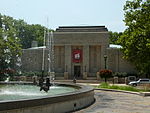The Archives of the Languages of the World
Archives in the United StatesIndiana University Bloomington
The Archives of the Languages of the World is a collection of sound recordings and documentation held at the Archives of Traditional Music at Indiana University, Bloomington, focused on documenting endangered languages around the world, particularly from the Americas. The collection is also known as the C.F. and F.M. Voegelin Archives of the Languages of the World.
Excerpt from the Wikipedia article The Archives of the Languages of the World (License: CC BY-SA 3.0, Authors).The Archives of the Languages of the World
East 3rd Street, Bloomington
Geographical coordinates (GPS) Address Nearby Places Show on map
Geographical coordinates (GPS)
| Latitude | Longitude |
|---|---|
| N 39.165277777778 ° | E -86.519722222222 ° |
Address
Sarah Parke Morrison Hall
East 3rd Street 1165
47405 Bloomington
Indiana, United States
Open on Google Maps





